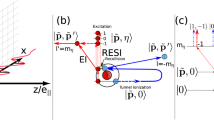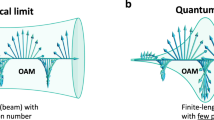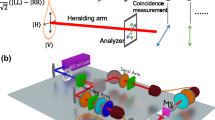Abstract
Photons can carry angular momentum, which is conventionally attributed to two constituents—spin angular momentum (SAM), which is an intrinsic property related to the polarization, and orbital angular momentum (OAM), which is related to the photon spatial distribution. In paraxial optics, these two forms of angular momentum are separable1, such that entanglement can be induced between the SAM and the OAM of a single photon2,3 or of different photons in a multi-photon state4. In nanophotonic systems, however, the SAM and the OAM of a photon are inseparable5,6, so only the total angular momentum (TAM) serves as a good quantum number7,8,9. Here we present the observation of non-classical correlations between two photons in the near-field regime, giving rise to entanglement related to the TAM. We entangle those nanophotonic states by coupling photon pairs to plasmonic modes and use quantum imaging techniques10,11 to measure their correlations. We observe that entanglement in TAM leads to a completely different structure of quantum correlations of photon pairs, compared with entanglement related to the two constituent angular momenta. This work paves the way for on-chip quantum information processing using the TAM of photons as the encoding property for quantum information.
This is a preview of subscription content, access via your institution
Access options
Access Nature and 54 other Nature Portfolio journals
Get Nature+, our best-value online-access subscription
$32.99 / 30 days
cancel any time
Subscribe to this journal
Receive 51 print issues and online access
$199.00 per year
only $3.90 per issue
Buy this article
- Purchase on SpringerLink
- Instant access to full article PDF
Prices may be subject to local taxes which are calculated during checkout




Similar content being viewed by others
Data availability
The experimental data that support the findings presented in the paper and Supplementary Information and are available at https://github.com/yigali/near-field-ent-tam.
Code availability
The codes that support the findings presented here are available from https://github.com/yigali/near-field-ent-tam.
Change history
01 May 2025
In the version of this article initially published, there was an error in the order of color keys in Fig. 3j, where |ψ2⟩ appeared with the bottom blue bar and |ψ1⟩ appeared with the top red bar; the key has been amended in the HTML and PDF versions of the article.
References
Allen, L., Beijersbergen, M. W., Spreeuw, R. J. C. & Woerdman, J. P. Orbital angular momentum of light and the transformation of Laguerre–Gaussian laser modes. Phys. Rev. A 45, 8185–8189 (1992).
Stav, T. et al. Quantum entanglement of the spin and orbital angular momentum of photons using metamaterials. Science 361, 1101–1104 (2018).
Karimi, E. et al. Spin-orbit hybrid entanglement of photons and quantum contextuality. Phys. Rev. A 82, 022115 (2010).
Pan, J.-W. et al. Multiphoton entanglement and interferometry. Rev. Mod. Phys. 84, 777–838 (2012).
Gorodetski, Y., Niv, A., Kleiner, V. & Hasman, E. Observation of the spin-based plasmonic effect in nanoscale structures. Phys. Rev. Lett. 101, 043903 (2008).
Bliokh, K. Y., Rodríguez-Fortuño, F. J., Nori, F. & Zayats, A. V. Spin–orbit interactions of light. Nat. Photon. 9, 796–808 (2015).
Li, C.-F. Spin and orbital angular momentum of a class of nonparaxial light beams having a globally defined polarization. Phys. Rev. A 80, 063814 (2009).
Zhao, Y., Edgar, J. S., Jeffries, G. D. M., McGloin, D. & Chiu, D. T. Spin-to-orbital angular momentum conversion in a strongly focused optical beam. Phys. Rev. Lett. 99, 073901 (2007).
Krenn, M., Tischler, N. & Zeilinger, A. On small beams with large topological charge. New J. Phys. 18, 033012 (2016).
Defienne, H., Reichert, M. & Fleischer, J. W. General model of photon-pair detection with an image sensor. Phys. Rev. Lett. 120, 203604 (2018).
Ndagano, B. et al. Imaging and certifying high-dimensional entanglement with a single-photon avalanche diode camera. npj Quantum Inf. 6, 94 (2020).
Wang, J., Sciarrino, F., Laing, A. & Thompson, M. G. Integrated photonic quantum technologies. Nat. Photon. 14, 273–284 (2020).
Madsen, L. S. et al. Quantum computational advantage with a programmable photonic processor. Nature 606, 75–81 (2022).
Faraon, A. et al. Coherent generation of non-classical light on a chip via photon-induced tunnelling and blockade. Nat. Phys. 4, 859–863 (2008).
O’Brien, J. L., Furusawa, A. & Vučković, J. Photonic quantum technologies. Nat. Photon. 3, 687–695 (2009).
Reddy, D. V., Nerem, R. R., Nam, S. W., Mirin, R. P. & Verma, V. B. Superconducting nanowire single-photon detectors with 98% system detection efficiency at 1550 nm. Optica 7, 1649 (2020).
Harrow, A. W. & Montanaro, A. Quantum computational supremacy. Nature 549, 203–209 (2017).
Krenn, M., Hochrainer, A., Lahiri, M. & Zeilinger, A. Entanglement by path identity. Phys. Rev. Lett. 118, 080401 (2017).
Halder, M. et al. Entangling independent photons by time measurement. Nat. Phys. 3, 692–695 (2007).
Reimer, C. et al. Generation of multiphoton entangled quantum states by means of integrated frequency combs. Science 351, 1176–1180 (2016).
Mair, A., Vaziri, A., Weihs, G. & Zeilinger, A. Entanglement of the orbital angular momentum states of photons. Nature 412, 313–316 (2001).
Nagali, E. et al. Quantum information transfer from spin to orbital angular momentum of photons. Phys. Rev. Lett. 103, 013601 (2009).
Molina-Terriza, G., Torres, J. P. & Torner, L. Management of the angular momentum of light: preparation of photons in multidimensional vector states of angular momentum. Phys. Rev. Lett. 88, 013601 (2001).
Kwiat, P. G. et al. New high-intensity source of polarization-entangled photon pairs. Phys. Rev. Lett. 75, 4337–4341 (1995).
Simon, C. & Pan, J.-W. Polarization entanglement purification using spatial entanglement. Phys. Rev. Lett. 89, 257901 (2002).
Müller, M., Bounouar, S., Jöns, K. D., Glässl, M. & Michler, P. On-demand generation of indistinguishable polarization-entangled photon pairs. Nat. Photon. 8, 224–228 (2014).
Fabre, C. & Treps, N. Modes and states in quantum optics. Rev. Mod. Phys. 92, 035005 (2020).
Devlin, R. C., Ambrosio, A., Rubin, N. A., Mueller, J. P. B. & Capasso, F. Arbitrary spin-to–orbital angular momentum conversion of light. Science 358, 896–901 (2017).
Beth, R. A. Mechanical detection and measurement of the angular momentum of light. Phys. Rev. 50, 115–125 (1936).
Fickler, R. et al. Quantum entanglement of high angular momenta. Science 338, 640–643 (2012).
Wang, J. et al. Terabit free-space data transmission employing orbital angular momentum multiplexing. Nat. Photon. 6, 488–496 (2012).
Fickler, R. et al. Interface between path and orbital angular momentum entanglement for high-dimensional photonic quantum information. Nat. Commun. 5, 4502 (2014).
Ostrovsky, E., Cohen, K., Tsesses, S., Gjonaj, B. & Bartal, G. Nanoscale control over optical singularities. Optica 5, 283 (2018).
Tsesses, S., Cohen, K., Ostrovsky, E., Gjonaj, B. & Bartal, G. Spin–orbit interaction of light in plasmonic lattices. Nano Lett. 19, 4010–4016 (2019).
Van Enk, S. J. & Nienhuis, G. Commutation rules and eigenvalues of spin and orbital angular momentum of radiation fields. J. Mod. Opt. 41, 963–977 (1994).
Das, P., Yang, L.-P. & Jacob, Z. What are the quantum commutation relations for the total angular momentum of light? tutorial. J. Opt. Soc. Am. B 41, 1764 (2024).
Shitrit, N. et al. Spin-optical metamaterial route to spin-controlled photonics. Science 340, 724–726 (2013).
Kher-Aldeen, J. et al. Dynamic control and manipulation of near-fields using direct feedback. Light Sci. Appl. 13, 298 (2024).
Lopez-Mago, D. & Gutiérrez-Vega, J. C. Shaping Bessel beams with a generalized differential operator approach. J. Opt. 18, 095603 (2016).
Soares, W. C., Caetano, D. P. & Hickmann, J. M. Hermite–Bessel beams and the geometrical representation of nondiffracting beams with orbital angular momentum. Opt. Express 14, 4577 (2006).
Frischwasser, K. et al. Real-time sub-wavelength imaging of surface waves with nonlinear near-field optical microscopy. Nat. Photon. 15, 442–448 (2021).
Milione, G., Sztul, H. I., Nolan, D. A. & Alfano, R. R. Higher-order Poincaré sphere, Stokes parameters, and the angular momentum of light. Phys. Rev. Lett. 107, 053601 (2011).
Dieleman, F., Tame, M. S., Sonnefraud, Y., Kim, M. S. & Maier, S. A. Experimental verification of entanglement generated in a plasmonic system. Nano Lett. 17, 7455–7461 (2017).
Tame, M. S. et al. Quantum plasmonics. Nat. Phys. 9, 329–340 (2013).
Fakonas, J. S., Mitskovets, A. & Atwater, H. A. Path entanglement of surface plasmons. New J. Phys. 17, 023002 (2015).
Dowling, J. P. Quantum optical metrology—the lowdown on high-N00N states. Contemp. Phys. 49, 125–143 (2008).
Howell, J. C., Bennink, R. S., Bentley, S. J. & Boyd, R. W. Realization of the Einstein–Podolsky–Rosen paradox using momentum- and position-entangled photons from spontaneous parametric down conversion. Phys. Rev. Lett. 92, 210403 (2004).
Bavaresco, J. et al. Measurements in two bases are sufficient for certifying high-dimensional entanglement. Nat. Phys. 14, 1032–1037 (2018).
Dai, D. Silicon nanophotonic integrated devices for on-chip multiplexing and switching. J. Lightwave Technol. 35, 572–587 (2017).
Orcutt, J. S. et al. Nanophotonic integration in state-of-the-art CMOS foundries. Opt. Express 19, 2335 (2011).
Olivieri, L. et al. Terahertz nonlinear ghost imaging via plane decomposition: toward near-field micro-volumetry. ACS Photon. 10, 1726–1734 (2023).
Ryczkowski, P., Barbier, M., Friberg, A. T., Dudley, J. M. & Genty, G. Ghost imaging in the time domain. Nat. Photon. 10, 167–170 (2016).
Popov, E. (ed.) Gratings: Theory and Numeric Applications, Second Revisited Edition (Institut Fresnel, 2014).
Johnson, K. C. Projection operator method for biperiodic diffraction gratings with anisotropic/bianisotropic generalizations. J. Opt. Soc. Am. A 31, 1698 (2014).
Hong, M., Dawkins, R. B., Bertoni, B., You, C. & Magaña-Loaiza, O. S. Nonclassical near-field dynamics of surface plasmons. Nat. Phys. 20, 830–835 (2024).
Lawrie, B. J., Evans, P. G. & Pooser, R. C. Extraordinary optical transmission of multimode quantum correlations via localized surface plasmons. Phys. Rev. Lett. 110, 156802 (2013).
Huck, A. et al. Demonstration of quadrature-squeezed surface plasmons in a gold waveguide. Phys. Rev. Lett. 102, 246802 (2009).
Fasel, S. et al. Energy-time entanglement preservation in plasmon-assisted light transmission. Phys. Rev. Lett. 94, 110501 (2005).
Altewischer, E., van Exter, M. P. & Woerdman, J. P. Plasmon-assisted transmission of entangled photons. Nature 418, 304–306 (2002).
Chang, D. E., Sørensen, A. S., Hemmer, P. R. & Lukin, M. D. Quantum optics with surface plasmons. Phys. Rev. Lett. 97, 053002 (2006).
Ren, X. F., Guo, G. P., Huang, Y. F., Li, C. F. & Guo, G. C. Plasmon-assisted transmission of high-dimensional orbital angular-momentum entangled state. Europhys. Lett. 76, 753–759 (2006).
Machado, F., Rivera, N., Buljan, H., Soljačić, M. & Kaminer, I. Shaping polaritons to reshape selection rules. ACS Photon. 5, 3064–3072 (2018).
Bliokh, K. Y., Niv, A., Kleiner, V. & Hasman, E. Geometrodynamics of spinning light. Nat. Photon. 2, 748–753 (2008).
Spektor, G., David, A., Gjonaj, B., Bartal, G. & Orenstein, M. Metafocusing by a metaspiral plasmonic lens. Nano Lett. 15, 5739–5743 (2015).
Kam, A. et al. Non-classical correlation between mode-entangled pairs of surface plasmon polaritons. In Proc. CLEO: Fundamental Science FF2C.5 (Optica Publishing Group, 2023).
Wright, W. E. Parallelization of Bresenham’s line and circle algorithms. IEEE Comput. Graph. Appl. 10, 60–67 (1990).
Gareth, J., Daniela, W., Trevor, H. & Robert, T. An Introduction to Statistical Learning Vol. 112 (Springer, 2013).
Ilin, Y. & Arad, I. Learning a quantum channel from its steady-state. New J. Phys. 26, 073003 (2024).
Kingma, D. P. & Ba, J. Adam: a method for stochastic optimization. Preprint at https://arxiv.org/abs/1412.6980 (2014).
Pelucchi, E. et al. The potential and global outlook of integrated photonics for quantum technologies. Nat. Rev. Phys. 4, 194–208 (2021).
Loredo, J. C. et al. Generation of non-classical light in a photon-number superposition. Nat. Photon. 13, 803–808 (2019).
Crespi, A. et al. Integrated photonic quantum gates for polarization qubits. Nat. Commun. 2, 566 (2011).
Marsili, F. et al. Detecting single infrared photons with 93% system efficiency. Nat. Photon. 7, 210–214 (2013).
Wang, J. et al. Multidimensional quantum entanglement with large-scale integrated optics. Science 360, 285–291 (2018).
Sit, A. et al. High-dimensional intracity quantum cryptography with structured photons. Optica 4, 1006 (2017).
Reid, M. D. et al. The Einstein–Podolsky–Rosen paradox: from concepts to applications. Rev. Mod. Phys. 81, 1727–1751 (2009).
Acknowledgements
This research was supported by the Israeli innovation authority through the MAGNET programme, grant number 73756, and was supported by the Israel Science Foundation (ISF), grant number 3620/24. We acknowledge the Russell Berrie Nanotechnology Institute, Micro-Nano Fabrication Unit (MNFU) and the Hellen Diller Quantum Center for their support of this research. A.K. acknowledges support by the programme for graduate students in the fields of natural sciences, engineering and medical professions by Israel Ministry of Innovation, Science, and Technology and the support from Helen Diller Quantum Center at the Technion. S.T. acknowledges support from the Adams fellowship programme of the Israel Academy of Science and Humanities, the Rothschild fellowship of the Yad Hanadiv foundation, the VATAT-Quantum fellowship of the Israel Council for Higher Education, the Helen Diller Quantum Center postdoctoral fellowship, and the Viterbi fellowship of the Technion – Israel Institute of Technology.
Author information
Authors and Affiliations
Contributions
G.B., S.T. and M.S. conceived of the project. A.K., S.T. and K.C. designed and fabricated the samples. A.K., S.T., Y.L., L.F. and A.P. built the experimental platform. A.K., L.F. and S.T. conducted the measurements. A.K., S.T., S.L. and Y.I. performed the simulations and analysed the experimental results. A.K., S.T., L.N.-L. and M.O. conducted the theoretical calculations. G.B., M.O., S.T. and M.S. supervised the project. All authors participated in writing the paper.
Corresponding author
Ethics declarations
Competing interests
The authors declare no competing interests.
Peer review
Peer review information
Nature thanks Daniele Faccio and the other, anonymous, reviewer(s) for their contribution to the peer review of this work.
Additional information
Publisher’s note Springer Nature remains neutral with regard to jurisdictional claims in published maps and institutional affiliations.
Extended data figures and tables
Extended Data Fig. 1 Coupling coefficient of the couplers.
Coupling coefficient as a function of the slit width and the grating period. Red dots represent the chosen configuration for our experiments. a. spiral in-coupler b. circular out-coupler.
Extended Data Fig. 2 SAM photo of the sample and cross-section of the couplers.
a. SAM photo of the experimental platform. in yellow the spiral coupler cross-section and in purple the circular out-coupler cross-section. b. The spiral input coupler (left photo), which creates the SPP entanglement is milled through the entire gold layer. c. The circular out-coupler ring (right photo) is milled only through 80 nm from it, scattering only SPPs towards the camera.
Extended Data Fig. 3 Experimental measurement of non-classical correlation.
a. Average intensity image of the of the plasmons that were out-coupled from the inner ring, in the case where two photons with circular polarization (\(|{\psi }_{1}\rangle \)) were launched. b-c. Examples of two correlation images (logarithmic scale) for the green and blue pixels marked in a. Highly positive correlations between antipodal pixels of the out-coupler give evidence of non-classical correlation between SPP pairs, indicating linear (elongated) states. d-f. Correlations of the out-coupled photons for the case where the two photons are launched with linear polarization (\(|{\psi }_{2}\rangle \)). Highly positive correlation with many pixels distributed along the circular coupler indicating a circularly symmetric state.
Extended Data Fig. 4 Explanation of the notation in the algorithm description.
Top row: Single correlative pixel case. Given a source pixel denoted by P, first we find the pixel denoted by O located on the outer radius \({R}_{2}\) of the annulus, such that the line from pixel P to pixel O intersects with the center of the annulus (see main text). We then traverse in clockwise direction on the outer radius \({R}_{2}\). Once the correlative pixel marked by the red square is found at angle \(\theta \), we increase the counter for the bin the angle \(\theta \) belongs to by \(+1\). Bottom row: Multiple correlative pixels case. The steps are exactly the same as for the single correlative pixel case, only now the counter in each bin is always normalized by the total sum of all counters across all bins, such that the resulting histogram will represent a valid probability distribution with respect to angle bins.
Extended Data Fig. 5 Correlation widths using the standard deviation.
a. The conditional probability distribution of the relative outcoupled angle of the entangled photons. b. Projection of joint probability distribution along the pulse-coordinates \({k}_{1}+{k}_{2}\). c. The conditional probability distribution of the relative transverse momentum of the entangled photons. The widths of the distributions determine the uncertainties in inferring the position or the momentum of one photon from that of the other. The solid lines are the theoretical predictions, and the dots are the experimental data.
Supplementary information
Supplementary Information
Supplementary Sections 1 and 2, including Supplementary Figs. 1 and 2—see contents for details.
Supplementary Video 1
Demonstrating the experimental set-up.
Supplementary Video 2
Non-classical correlations video for the state \(|{\psi }_{1}\rangle \). The green star symbolizes the pixel for which correlations are computed, and the heatmap represents the accumulated positive correlation with all green-star pixels thus far, showing high non-classical correlations between pixels at opposite sides of the out-coupler.
Supplementary Video 3
Non-classical correlations video for the state \(|{\psi }_{2}\rangle \). The green star symbolizes the pixel for which correlations are computed, and the heatmap represents the accumulated positive correlation with all green-star pixels thus far, showing high non-classical correlation with many, uniformly distributed, pixels in the out-coupler.
Rights and permissions
Springer Nature or its licensor (e.g. a society or other partner) holds exclusive rights to this article under a publishing agreement with the author(s) or other rightsholder(s); author self-archiving of the accepted manuscript version of this article is solely governed by the terms of such publishing agreement and applicable law.
About this article
Cite this article
Kam, A., Tsesses, S., Ilin, Y. et al. Near-field photon entanglement in total angular momentum. Nature 640, 634–640 (2025). https://doi.org/10.1038/s41586-025-08761-1
Received:
Accepted:
Published:
Issue Date:
DOI: https://doi.org/10.1038/s41586-025-08761-1



